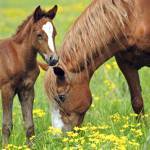Post-Foaling Checklist

After waiting eleven months to see that new baby, horse breeders are usually relieved when the mare finally delivers her foal. While all goes well in the majority of equine births, there are still a few things to check in the hours and days immediately after a foal is born.
Signs of trouble for the mare could include severe bleeding, an increased heart rate, or indications of colic. She might show some colic signs as she tries to expel the placenta, but if the signs continue or show up in the first few days after foaling, she could have internal damage or intestinal problems that will require treatment.
If the mare isn’t able to stand up within 20 to 30 minutes after foaling, or if she stands but is dull and uninterested in her foal, she should be examined by a veterinarian. She could have internal tearing, temporary nerve damage, or be in pain, and the sooner these problems are treated, the better the outcome will be for the mare and her foal.
Foals should stand within an hour and nurse within two hours of birth. Many foals are up and moving much sooner, even if they are somewhat unsteady on their feet. Foals that are unable to get up may be suffering from oxygen deprivation during delivery, broken ribs, or other defects. If the foal has not passed meconium (the blackish, tarry substance that builds up in the intestine before birth) within three hours, it might need an enema to help in eliminating this material.
The mare’s mammary glands should be producing colostrum, an antibody-rich, yellowish fluid that protects the foal from disease until its own immune system begins to function. Mares may leak colostrum before the foal is born, or the foal may not nurse enough to ingest a sufficient supply of this important fluid. Foals should have a blood test within about 24 hours of birth to be sure their immunoglobulin level is acceptable.
Foals that don’t nurse, avoid the mare, or display odd behaviors should be seen by a veterinarian. Any unusual condition in a newborn foal can potentially be life-threatening, so waiting to see if the issue will resolve on its own is usually not a good idea.








